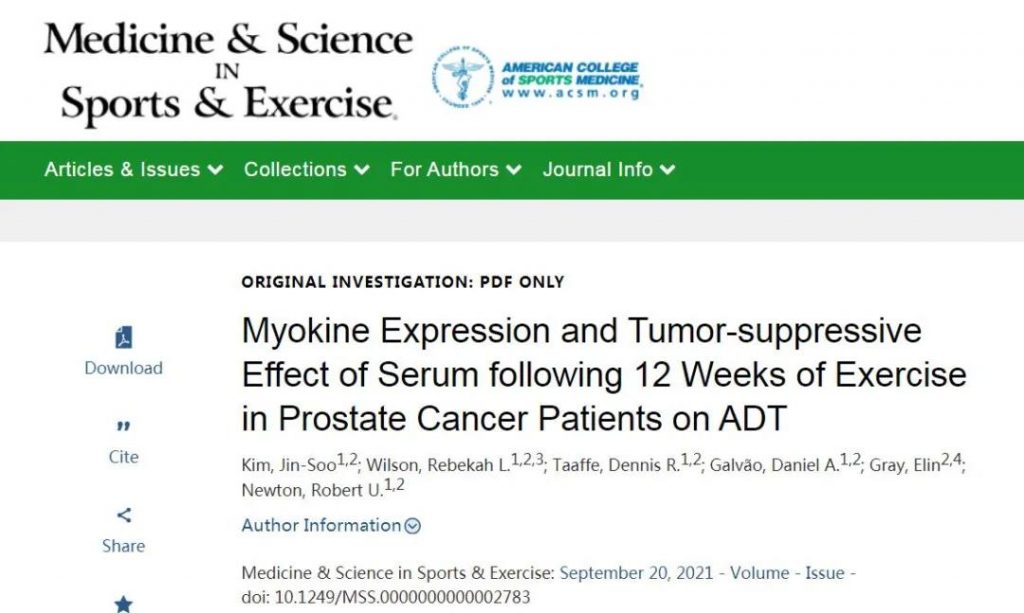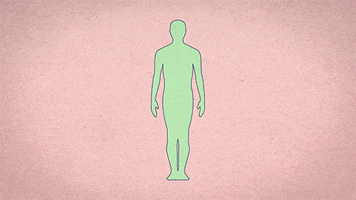
It is always said that life lies in exercise, so how does exercise improve or even “prolong” life? Recently, a new study found that insisting on exercise can form a “cancer suppression environment” in the body and reduce the risk of cancer.

How does exercise help the human body “fight cancer”?

Recently, a study published in Medicine & Science in Sports & Exercise found that exercise can not only improve overall health, but also release a “secret weapon” to slow down the growth of cancer cells and create a “cancer suppression environment” for the body.
The researchers asked 10 prostate cancer patients with an average age of 73 to carry out exercise intervention for 12 weeks, accumulating 300 minutes of exercise per week, including 5 to 9 resistance training for the main muscle groups of the upper and lower body, 1 to 4 groups each time, 6 to 12 repetitions of maximum intensity, each exercise lasting about 1 hour, and 5 to 10 minutes of aerobic warm-up and relaxation.
Researchers found that the blood after exercise has a significant inhibitory effect on the growth of these cancer cells, and long-term exercise can create an environment to inhibit cancer in the body.
Although the researchers studied only patients with prostate cancer, they said that the release of myocytokines into the blood should be effective for all forms of cancer.
Exercise can improve DNA
A study at the University of Copenhagen in Denmark found that a large part of the benefits of exercise are brought about by improving the structure of DNA.
The researchers asked healthy male participants with an average age of 23 to carry out endurance exercise training for 6 weeks. They found that after completing the endurance training program, the structure of many enhancers in participants’ skeletal muscle changed.
The segment with genetic information in DNA is called gene, and enhancer is a small segment of DNA that can bind to protein. After binding to protein, the transcription of gene will be strengthened.

The research team speculates that the beneficial effects of exercise on organs far away from muscles, such as the brain, may be achieved by signals released by muscles into the blood.
These physical signs remind you that it’s time to exercise
Lack of exercise can lead to a variety of health problems and even shorten life expectancy. If these 14 signs appear, it means you should exercise.
Frequent constipation
Regular exercise promotes intestinal peristalsis and helps to defecate smoothly. If you eat normally but often constipate, it may be because you exercise too little.
Joint stiffness
Moderate exercise helps to lubricate the joints and maintain their normal function. Proper physical activity can also reduce the discomfort of the joints.
Pant for breath
Lack of exercise will lead to the loss of strength of lung muscles, and a little activity will make you out of breath. Frequent wheezing indicates insufficient exercise.
Be subject to changing moods
Lack of exercise will not only damage health, but also increase anxiety and depression. Aerobic exercise such as walking, cycling, swimming and running can promote blood circulation, improve and stabilize mood.

Always tired
Exercise helps the body get enough oxygen and nutrition. Sedentary all day, easy to fatigue.
Slow metabolism
Lack of exercise will “block” the body and slow down metabolism, while exercise can accelerate metabolism. The more exercise, the more calories the body consumes.
Difficulty falling asleep
Regular exercise during the day is beneficial to reduce stress, improve sleep quality, and reduce the number of wakes at night.
Often forget things
Regular exercise can make the body produce more growth factors, which can promote the formation of cerebral blood vessels. The more blood entering the brain, the stronger the ability of thinking, memory and decision-making.

Elevated blood pressure
Sedentary can easily lead to high blood pressure, which is a major risk factor for heart attack.
Blood glucose instability
Regular exercise can better control blood glucose and maintain stable blood glucose level.
Have a sore waist and an aching back
The core muscle group will be used in and out. Once lack of exercise, even standing or reaching out will feel back pain and stiffness. Stretching exercises such as Pilates and yoga are good for strengthening back muscles.
Easily hungry
Many people believe that the more exercise, the stronger the sense of hunger and always want to eat. On the contrary, aerobic exercise such as cycling, swimming, walking and running can actually improve the level of “hunger hormone” in the body and help control overeating.
Easy fall ill
Moderate exercise can reduce the risk of diseases such as colds and influenza. Exercise can enhance immunity. Without exercise, the body’s resistance to disease will decline.
Dull skin
Long term lack of exercise will slow down the circulation and metabolism of the body and skin, resulting in excessive accumulation of waste and waste gas in the body, and the skin will turn yellow and dull.
Four kinds of sports prolong life
According to the analysis of 1 million 440 thousand people’s data, the American Cancer Center has found that exercise can significantly reduce the incidence rate of 13 kinds of cancer, which is between 10%~42%. The website of the American Medical daily also summarizes four popular sports that help prolong life: fast walking, running, swimming and playing badminton.

Fast walking
Strengthen the heart and lungs and increase the strength of lower limbs
A study by the Affiliated Hospital of the University of Saint Etienne in France found that the elderly who insist on fast walking for 15 minutes a day can reduce the risk of early death by 22%.
Fast walking is a good choice for exercise therapy and rehabilitation of chronic diseases. It can promote blood circulation, enhance metabolic capacity, regulate blood glucose, blood lipid and blood pressure, and prevent coronary heart disease; It also exercises the strength of lower limbs, which can strengthen tendons and bones, prevent osteoporosis, improve respiratory circulation, enhance gastrointestinal peristalsis and prevent constipation.
Running
Early death can be reduced regardless of length and speed
Based on the data analysis of 14 relevant studies involving 230000 people for 35 years by institutions such as the University of Victoria in Australia, it is found that running can reduce the risk of early death regardless of the length and speed of running. Running can reduce the risk of all-cause death, cardiovascular disease death and cancer death by 27%, 30% and 23% respectively.
The exercise intensity of running is greater, which is more conducive to promoting blood circulation and improving cardiopulmonary function. It can also enhance immunity. People who often run and exercise have a better physical level on the whole.

Swimming
Exercise the heart and lungs and coordinate the muscles of the whole body
A 10-year follow-up survey of more than 80000 people by the University of Edinburgh found that regular swimming can reduce the risk of early death by 28%; People who swim regularly have a 41% lower risk of dying of stroke or heart disease.
Swimming can improve cardiopulmonary function significantly and exercise the muscles of shoulder, back, waist, abdomen and legs, especially enhance muscle strength and coordination. Because of the buoyancy of water, it is not good for joints, especially for people with sports injury or chronic diseases.
Badminton
It can protect the heart and coordinate the whole body
A study in the British Journal of Sports Medicine found that swing sports can reduce the risk of all-cause death by 47%, and sports such as table tennis, tennis and badminton can reduce the risk of cardiovascular death by 56%.

In the process of playing badminton, the body needs to use the upper, lower limbs and trunk to coordinate the force. Hitting requires rapid response. It can run, jump and jump more during exercise, and can exercise the whole body. It is a comprehensive sport with multiple sports qualities such as strength, speed, endurance, balance, flexibility and response.
Remind
Exercise according to your ability
General healthy people: if there is no exercise habit, it is recommended that the upper limit of heart rate during exercise is “170 age”; People with exercise habits: the upper limit of heart rate is “180 age”.
Patients with diseases: especially those with cardiovascular diseases, follow the doctor’s advice to ensure reasonable exercise intensity and amount.
Healthy people should take moderate intensity aerobic exercise 3 ~ 5 times a week for at least 150 minutes, of which 75 minutes reach medium and high intensity
Comments